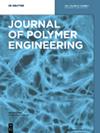Doped polymethyl methacrylate (PMMA) as proton exchange membrane for microbial fuel cell
IF 1.7
4区 工程技术
Q4 POLYMER SCIENCE
引用次数: 0
Abstract
The urgent need for clean and affordable energy solutions to combat energy scarcity and global warming is paramount. Fuel cells, particularly microbial fuel cells (MFCs), offer a promising avenue for sustainable energy production. Proton exchange membranes (PEMs) are critical components in MFCs, but the high cost of Nafion, the gold standard PEM, poses a significant challenge. In this pioneering study, we tried to fabricate PEMs by crafting them from polymethyl methacrylate (PMMA), coupled with innovative combinations of potassium thiocyanate (KSCN) and citric acid. The synthesized membranes were studied for their water uptake capacity, ion exchange capacity and potential applications in MFC. The maximum remarkable water uptake capacities of up to 70 % for 10 % KSCN and 64 % for 7.5 % citric acid compositions was observed. Furthermore, these PEMs exhibit ion exchange capacities (IEC) ranging from 0.024 to an impressive 0.69 meq/gm, with the 7.5 % citric acid variant showcasing the highest IEC (0.69 meq/gm). The membranes having better IEC were applied to microbial fuel cell. This results in maximum power density of 50.03 μw/cm掺杂聚甲基丙烯酸甲酯(PMMA)作为微生物燃料电池的质子交换膜
为应对能源短缺和全球变暖问题,迫切需要清洁且负担得起的能源解决方案。燃料电池,尤其是微生物燃料电池(MFC),为可持续能源生产提供了一条前景广阔的途径。质子交换膜(PEM)是 MFC 的关键部件,但黄金标准 PEM Nafion 的高昂成本带来了巨大挑战。在这项开创性的研究中,我们尝试用聚甲基丙烯酸甲酯(PMMA)与硫氰酸钾(KSCN)和柠檬酸的创新组合来制造 PEM。研究了合成膜的吸水能力、离子交换能力以及在 MFC 中的潜在应用。在 10% 的硫氰酸钾(KSCN)和 7.5% 的柠檬酸(Citric Acid)成分中,观察到的最大吸水能力分别高达 70% 和 64%。此外,这些 PEM 的离子交换能力(IEC)从 0.024 到令人印象深刻的 0.69 meq/gm,其中 7.5 % 柠檬酸变体的 IEC 最高(0.69 meq/gm)。具有更好 IEC 的膜被应用于微生物燃料电池。这使得最大功率密度达到 50.03 μw/cm2,凸显了这些膜作为 MFC 中传统 PEM 的一种具有成本效益且环保的替代品所具有的巨大潜力。
本文章由计算机程序翻译,如有差异,请以英文原文为准。
求助全文
约1分钟内获得全文
求助全文
来源期刊

Journal of Polymer Engineering
工程技术-高分子科学
CiteScore
3.20
自引率
5.00%
发文量
95
审稿时长
2.5 months
期刊介绍:
Journal of Polymer Engineering publishes reviews, original basic and applied research contributions as well as recent technological developments in polymer engineering. Polymer engineering is a strongly interdisciplinary field and papers published by the journal may span areas such as polymer physics, polymer processing and engineering of polymer-based materials and their applications. The editors and the publisher are committed to high quality standards and rapid handling of the peer review and publication processes.
 求助内容:
求助内容: 应助结果提醒方式:
应助结果提醒方式:


